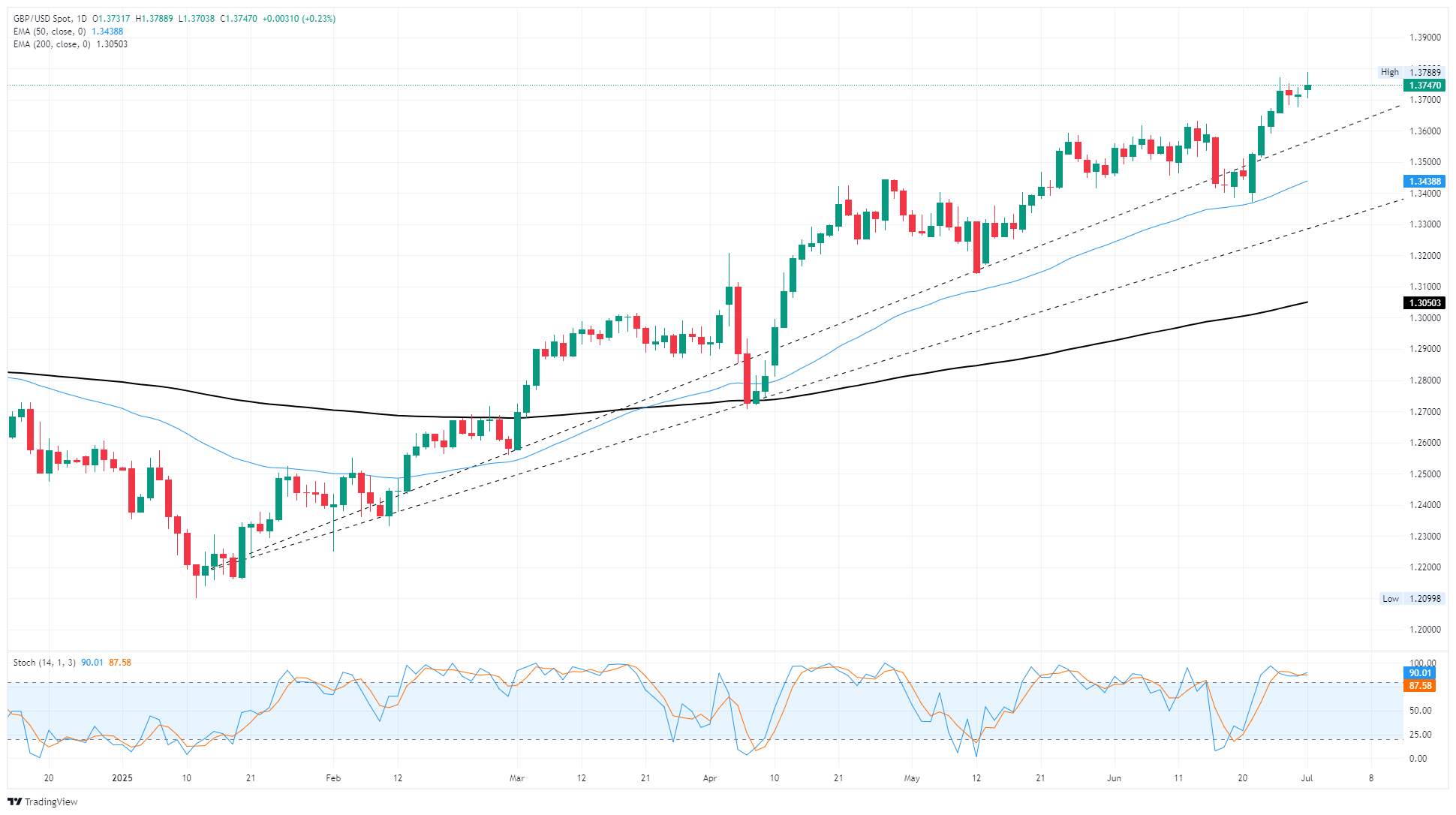GBP/USD teases new highs as Greenback pummeling continues
- GBP/USD clipped yet another fresh high, reaching a 45-month peak on Tuesday.
- The US Dollar is getting crushed across the board, bolstering the Pound into higher ground.
- Markets are gearing up for an early US NFP print on Thursday, with a US holiday on Friday.
GBP/USD poked into its highest bids in 45 months on Tuesday, knocking a few inches closer to four-year highs as the US Dollar’s broad-market pummeling continues unabated. Lopsided trade policies, further aggravated by public musings about steep tariffs by President Donald Trump are keeping Greenback bidders on the ropes as counter-currencies continue to grind into multi-year highs.
Economic data and appearances by central bank heads took a backseat to trade and budget concerns on Tuesday. The US Senate has finally passed some version of President Trump’s “big, beautiful budget bill”, which now heads to the US House of Representatives for a final pass and another vote. Trump, who campaigned on eliminating the US’s federal deficit overhang, is poised to write his spending bill into law, which will add trillions of dollars to the US debt load over the next decade.
Trump hit markets with fresh trade war threats on Tuesday, warning that Japan could be the next to face 30-35% tariffs on all goods imported into the US. President Trump has had a spotty track record of enacting his own often-threatened import taxes, but continues to shift the target from one week to the next. President Trump also reiterated that he has no intention of further delaying his reciprocal tariff package that was suspended after being announced in April, which are due to come back into effect from July 9.
US Nonfarm Payrolls data will be released a day early this week, with a US federal holiday on the cards for Friday. Thursday’s NFP print is expected to ease back to 110K from 139K, and investors will be keeping a close eye on any sharp downside revisions in previous months’ figures.
GBP/USD price forecast
GBP/USD has ridden a bullish wave into fresh 45-month highs this week, testing above 1.3780 for the first time since October of 2021. The pair has also closed in the green for a fifth straight month as the US Dollar broadly weakens across the board.
Cable bidders may be flying too close to the sun as GBP/USD prices quickly outrun rising trendlines, with price action trading well above the 200-day Exponential Moving Average (EMA) near 1.3080. Technical oscillators are pinned in overbought territory, warning of a potential pullback on the cards.
GBP/USD daily chart

Pound Sterling FAQs
The Pound Sterling (GBP) is the oldest currency in the world (886 AD) and the official currency of the United Kingdom. It is the fourth most traded unit for foreign exchange (FX) in the world, accounting for 12% of all transactions, averaging $630 billion a day, according to 2022 data. Its key trading pairs are GBP/USD, also known as ‘Cable’, which accounts for 11% of FX, GBP/JPY, or the ‘Dragon’ as it is known by traders (3%), and EUR/GBP (2%). The Pound Sterling is issued by the Bank of England (BoE).
The single most important factor influencing the value of the Pound Sterling is monetary policy decided by the Bank of England. The BoE bases its decisions on whether it has achieved its primary goal of “price stability” – a steady inflation rate of around 2%. Its primary tool for achieving this is the adjustment of interest rates. When inflation is too high, the BoE will try to rein it in by raising interest rates, making it more expensive for people and businesses to access credit. This is generally positive for GBP, as higher interest rates make the UK a more attractive place for global investors to park their money. When inflation falls too low it is a sign economic growth is slowing. In this scenario, the BoE will consider lowering interest rates to cheapen credit so businesses will borrow more to invest in growth-generating projects.
Data releases gauge the health of the economy and can impact the value of the Pound Sterling. Indicators such as GDP, Manufacturing and Services PMIs, and employment can all influence the direction of the GBP. A strong economy is good for Sterling. Not only does it attract more foreign investment but it may encourage the BoE to put up interest rates, which will directly strengthen GBP. Otherwise, if economic data is weak, the Pound Sterling is likely to fall.
Another significant data release for the Pound Sterling is the Trade Balance. This indicator measures the difference between what a country earns from its exports and what it spends on imports over a given period. If a country produces highly sought-after exports, its currency will benefit purely from the extra demand created from foreign buyers seeking to purchase these goods. Therefore, a positive net Trade Balance strengthens a currency and vice versa for a negative balance.

